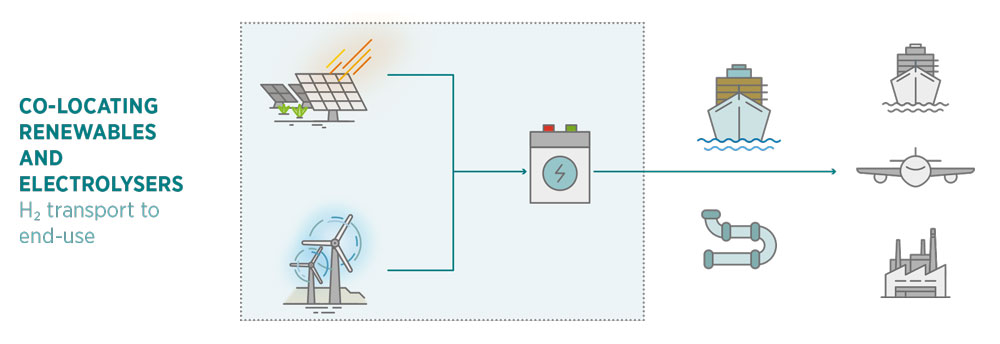Hydrogen trade
Overview of the status and impact of the innovation

What
Electrolysers earn their revenues primarily from supplying hydrogen to meet various types of demand. When the electrolyser is not co-located with the end use, hydrogen transportation and trade is needed. National and international hydrogen trade involves transporting hydrogen and its derivatives via pipelines or in ships. Long-distance trade, usually via ships, can unlock the abundant renewable energy potential in many remote locations by allowing hydrogen to reach markets far from production sites (Figure 9.10). To encourage and facilitate such trade, countries have begun to establish bilateral relations and deals concerning hydrogen molecules and related production technologies. It will also be necessary to use certification schemes, such as certificates, to build trust in green hydrogen, ammonia, methanol and other e-fuels.
FIGURE 9.10 Transporting hydrogen to end-use locations

Why
The development of an international hydrogen trade market would greatly accelerate the uptake of green hydrogen. Hydrogen trade will help secure the demand for green hydrogen in areas with limited renewable resources. By 2050, one-quarter of all the hydrogen produced could be globally traded, with about equal shares transported by pipelines and ammonia ships (IRENA, 2022e).
BOX 9.21 Chile as a hydrogen exporter; Japan as a hydrogen importer
Chile has the potential to become one of the world’s largest green hydrogen producers and exporters. The Magallanes region in southern Chile (a region with substantial wind resources) already has a combined electrolyser and wind turbine facility (see Box 9.17). In the north, the Atacama Desert receives some of the highest global solar irradiation, which could be harnessed by solar facilities and electrolysers. Chile also has the necessary infrastructure and port experience to become a large green hydrogen exporter and is already in discussions with Singapore and the Port of Rotterdam.
Japan has already taken steps towards large-scale hydrogen imports. Four Japanese companies (Iwatani Corporation, Kawasaki Heavy Industries Ltd., Kansai Electric Power Co. Inc. and Marubeni Corp.) have signed a memorandum with two Australian energy infrastructure firms (Stanwell Corp and APT Management Services Pty Ltd.) for the Central Queensland Hydrogen Project. The project will produce hydrogen using power from the 600 MW Aldoga solar project in Queensland, liquefy the hydrogen at the Port of Gladstone and ship the liquefied hydrogen to Japan.
Related kits
Power to hydrogen innovations
Innovations (30)
-
Technology and infrastructure
- 1 Pressurised alkaline electrolysers
- 2 Polymer electrolyte membrane electrolysers
- 3 Solid oxide electrolyser cell electrolysers
- 4 Anion exchange membrane electrolysers
- 5 Compressed hydrogen storage
- 6 Liquefied hydrogen storage
- 7 Hydrogen-ready equipment
- 8 Digital backbone for green hydrogen production
- 9 Hydrogen leakage detection
-
Market design and regulation
- 10 Additionality principle
- 11 Renewable power purchase agreements for green hydrogen
- 12 Cost-reflective electricity tariffs
- 13 Electrolysers as grid service providers
- 14 Certificates
- 15 Hydrogen purchase agreements
- 16 Carbon contracts for difference
- 17 Regulatory framework for hydrogen network
- 18 Streamline permitting for hydrogen projects
- 19 Quality infrastructure for green hydrogen
- 20 Regulatory sandboxes
-
System planning and operation
-
Business models